
The deer are very beautiful animals. They are famous for their speed, grace and good look. Deer are the ruminant mammals forming the family Cervidae. They include for example Moose, Red Deer, Reindeer, Roe and Chital. Animals from related families within the order Artiodactyla (even-toed ungulates) are often also considered to be deer – these include muntjac and water deer. Male (and a few female) deer of all species (except the Chinese Water deer who only have short tusks instead) grow and shed new antlers each year – in this they differ from permanently horned animals such as antelope – these are in the same order as deer and may bear a superficial resemblance. The musk deer of Asia and Water Chevrotain (or Mouse Deer) of tropical African and Asian forests are not usually regarded as true deer and form their own families, Moschidae and Tragulidae, respectively. The gazelle is hunted for the sake of its delicious flesh, fat and beautiful hide. Many people and professional hunters take keen interest in antelope hunt its delicious flesh, fat and beautiful hide. Many people and professional hunters take keen interest in antelope hunting. Now, people in Pakistan capture fawns and antelopes to keep as fancy/pet animals in houses. Unfortunately, people do not understand surveillance and management of these wild animals. Therefore mostly fractures, damages to the skin and other parts of the body of the animal occur during capture and transport. Fracture of the forelimbs, hind limbs and of the pelvis are relatively common in antelopes, when predators attack them.
Case History:
A 2 years old zoo female deer was presented having fractured hind leg.
DIAGNOSIS:
Clinical examination revealed swelling, pain and crepitus sound s on palpation in left hind leg. Whereas, left forelimb’s skin was damaged. Deer was standing on her leg with laming gait. There was a damage to the skin and bone in hind leg.
TREATMENT:
Treatment was basd on conservative management. Deer was kept in rest, activity was limited and measures were taken to ensure regular urination and defaecation. Animal was restrained and placed laterally to make plastering with Gypsona (plaster of Paris) of hind leg.
.jpg)



No comments:
Post a Comment